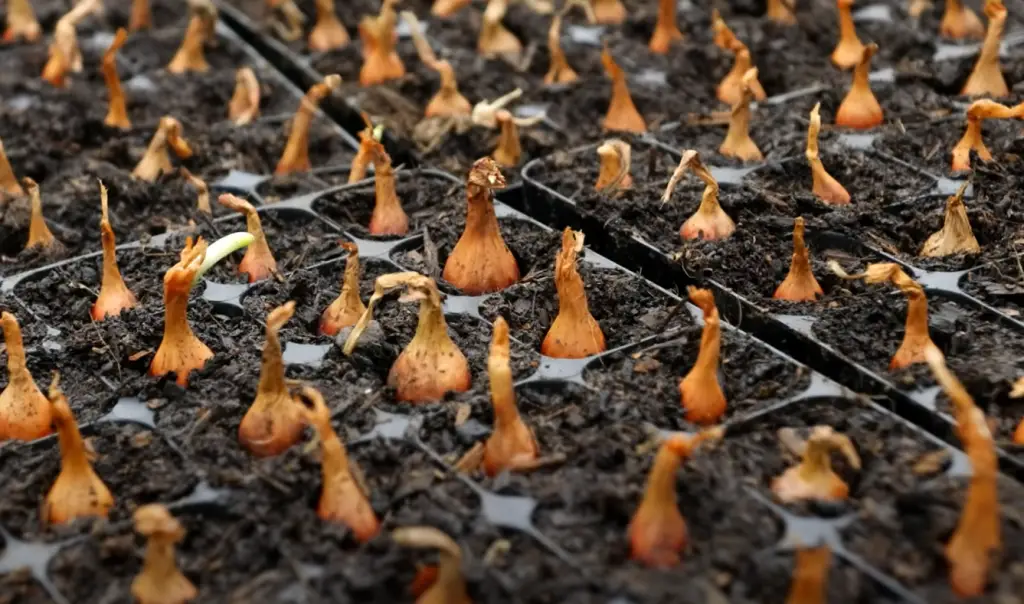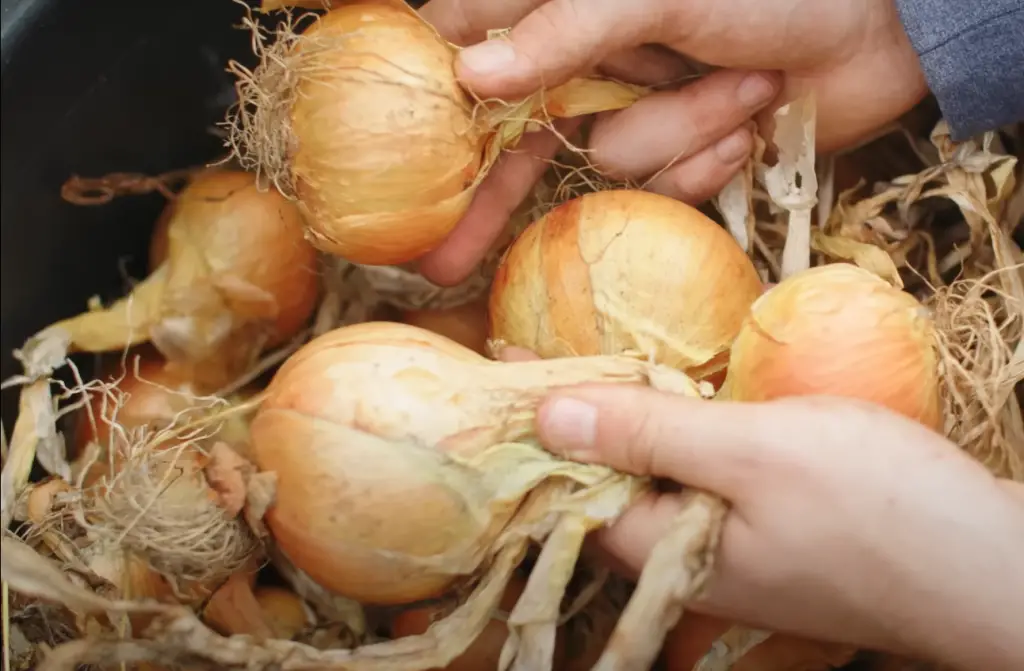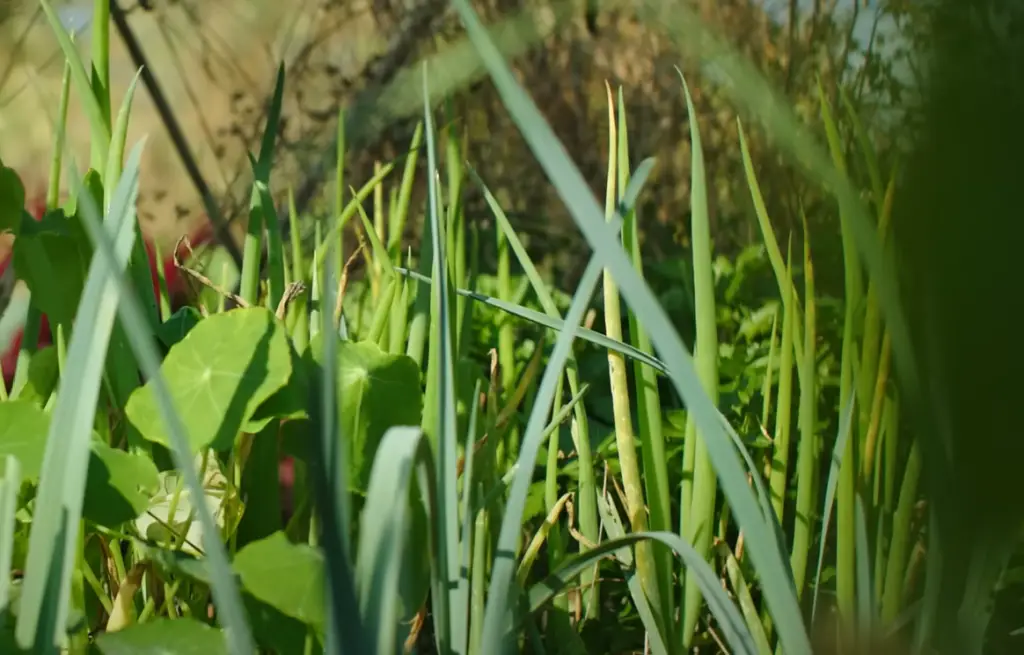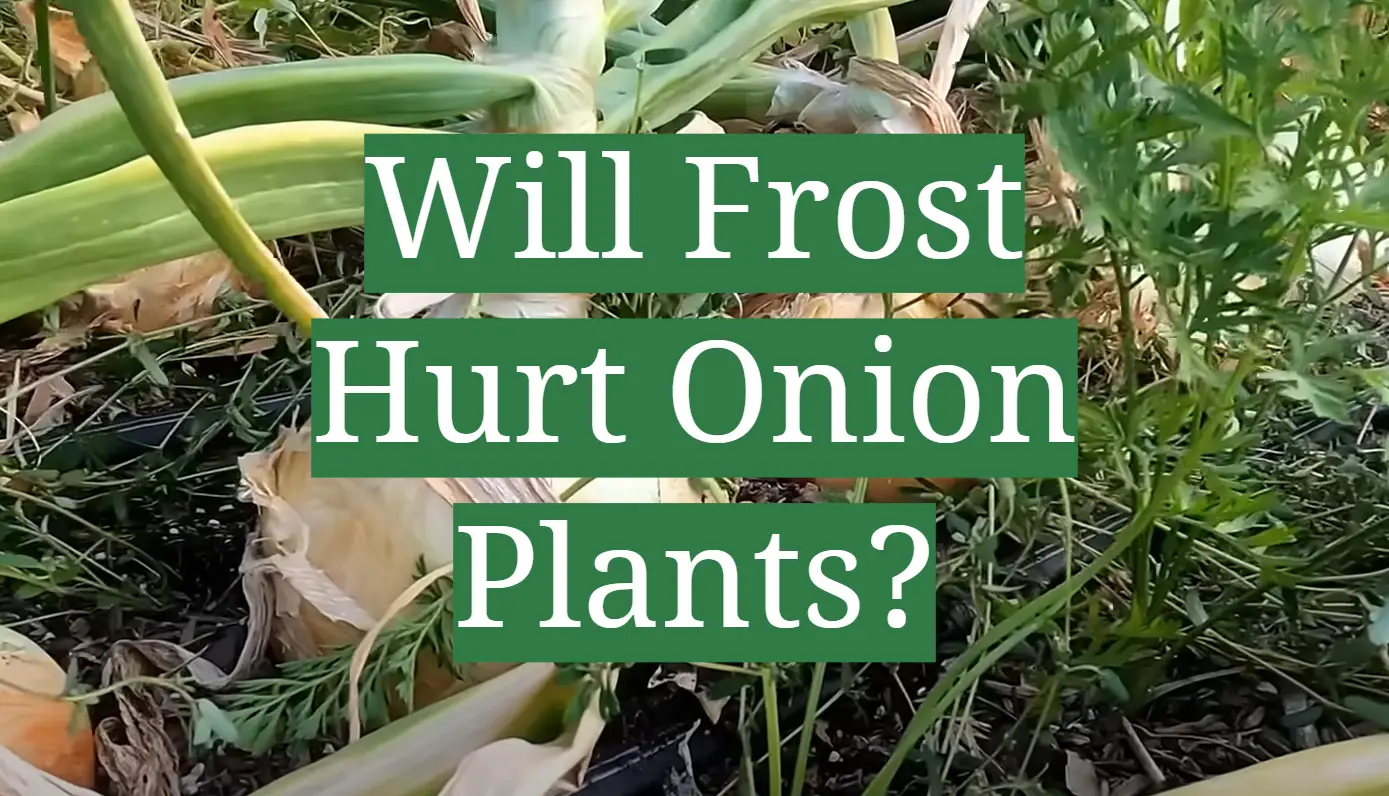Onion plants are a popular vegetable choice for many home gardeners, but they can be particularly susceptible to frost. When temperatures drop below freezing, even briefly, onion plant leaves and stems will wilt or die off. Knowing how to protect your onions from frost can help ensure that you get a good crop every season.
In this article, we’ll answer some common questions about frost and onion plants, and offer some useful tips on how to protect your onions from the cold.
Can Frost Hurt Onion Plants?
Yes, frost can hurt onion plants.
If your onions are exposed to frost, you may see browning of the plant tissue, which indicates damage from the cold.[2]Protecting Your Onions From Frost
The best way to protect your onions from frost is to ensure that they are planted in the right place at the right time. Plant your onions as early in spring as possible, so they have time to grow and establish a strong root system before temperatures drop too low. You should also choose an area of your garden that gets plenty of sunlight, as this will help keep the soil temperature higher.

In addition, you can cover your onions with a layer of mulch before temperatures start to drop. Mulching your onions will help insulate them from frost and cold temperatures, as well as helping them retain moisture and reducing weed growth. Finally, you can also cover your onion plants overnight with a frost blanket or plastic sheeting if temperatures are expected to drop very low. This will help keep the delicate leaves and stems from damage due to cold temperatures.
How to Grow Onions?
Growing onions is a great way to add delicious flavor and texture to your meals. Onions are easy to grow, and will thrive in most climates. When planting your onion seeds or sets, make sure you choose an area with well-draining soil that gets plenty of sunlight.
Once the onions start to appear, thin out any overcrowded plants to give the remaining onions enough space to grow. Make sure to keep the soil moist, and fertilize your onion plants every few weeks with a balanced fertilizer. Finally, protect your onion plants from frost as mentioned above. With proper care, you’ll have a bumper crop of delicious onions in no time!
Harvesting Onions
When it’s time to harvest your onions, wait until the tops of the plants turn yellow and start to fall over. Carefully dig up your onions with a garden fork, then leave them in a sunny spot for several hours to dry. Once they are completely dry, clip off the roots and tops, and store in a cool, dark place.[2]
Pests and Diseases
Onions can sometimes be affected by pests or diseases, just like any other vegetable crop. You can prevent infection by planting disease-resistant varieties, rotating your crops each season to avoid repetitive problems, and keeping a general eye out for any signs of distress in your plants.

If you do encounter an infestation or disease, there are several organic pest control solutions that can be used to manage the problem.
Do you have to cover onions from frost?
The best way to protect your onions from frost is to ensure that they are planted in the right place at the right time. Plant your onions early in spring and choose an area of your garden that gets plenty of sunlight. Additionally, you can cover your onion plants overnight with a frost blanket or plastic sheeting if temperatures are expected to drop very low. This will help keep the delicate leaves and stems from damage due to cold temperatures.
Finally, you can also harvest your onions early if a hard frost is forecasted. This will help minimize any damage that could occur from the cold temperatures. Taking these simple steps will ensure that your onion plants remain healthy and productive throughout the season![2]
Will frost hurt onions?
Frost can hurt onion plants, so it is important to take steps to protect them when temperatures start to drop. Onions are a cool-season crop that is sensitive to cold temperatures, and even a brief exposure to freezing temperatures can cause wilting or death of the leaves and stems. If your onions are exposed to frost, you may see browning of the plant tissue, which indicates damage from the cold.
However, by taking steps to protect your onions such as planting them early in spring, choosing an area of your garden that gets plenty of sunlight, mulching around the plants, and covering them with frost blankets or plastic sheeting if needed, you can help minimize any potential damage due to frost. Additionally, harvesting your onions early if a hard frost is forecasted can also help minimize damage. Taking these simple steps will ensure that your onion plants remain healthy and productive throughout the season!
What is the best way to store onions?
Onions can last for several weeks or months when stored properly. To ensure your onions stay in good condition, make sure to clip off the roots and leaves before storage. Onions should be kept in a cool, dark place with plenty of ventilation. Avoid storing onions in plastic bags or containers as they tend to retain moisture which can cause them to rot more quickly.

You can also freeze onions if you plan to use them later in the season. Simply peel and chop your onions, then spread them out on a baking sheet lined with parchment paper. Place the tray in the freezer until the pieces are frozen solid, then transfer them to an airtight container or zip-top bag. Frozen onions will last for up to six months, so you can enjoy them all year round.[1]
When should you harvest onions?
When it’s time to harvest your onions, wait until the tops of the plants turn yellow and start to fall over. This is a sign that the bulbs have grown fully, and are ready to be harvested. Carefully dig up your onions with a garden fork, then leave them in a sunny spot for several hours to dry. Once they are completely dry, clip off the roots and tops, and store in a cool, dark place. Enjoy your delicious homegrown onions!
What happens if onions get frosted?
If your onions get frosted, they may become wilted or die. Frost can cause browning of the plant tissue, which indicates damage from the cold. Additionally, there is a risk that the frosted onion bulbs will rot in storage due to the cold temperatures. To avoid this, make sure to harvest your onions as soon as possible after exposure to frost and store them in a cool, dark place. Taking these steps will help ensure that your onions remain fresh and delicious![1]
How cold is too cold for onions?
Onions are a cool-season crop that is sensitive to cold temperatures, and even a brief exposure to freezing temperatures can cause wilting or death of the leaves and stems. The optimal temperature for growing onions is between 45°F (7°C) and 75°F (24°C).
Covering them with a frost blanket or plastic sheeting overnight, mulching around the plants, and harvesting early if a hard frost is forecasted can all help minimize any potential damage due to cold temperatures. Follow these easy steps and you’ll be sure to have healthy, delicious onions in your garden all season long!When should you harvest onions?
When it’s time to harvest your onions, wait until the tops of the plants turn yellow and start to fall over. This is a sign that the bulbs have grown fully, and are ready to be harvested. Carefully dig up your onions with a garden fork, then leave them in a sunny spot for several hours to dry. Once they are completely dry, clip off the roots and tops, and store in a cool, dark place. Your onions are now ready to be used in your favorite dishes!

To ensure that they last throughout the season, avoid storing onions with potatoes or apples as this can cause them to spoil quicker. Additionally, if you plan on keeping your onions for an extended time period, it may be beneficial to place them in the refrigerator. Doing this will help preserve their freshness and flavor for months on end! Enjoy your delicious homegrown onions all season long with these easy tips![1]
Onions left in the ground over winter
Onions that are left in the ground over winter can be vulnerable to cold temperatures and frost, which can cause wilting or death of the leaves and stems. To prevent this from happening, take steps such as mulching around the plants and covering them with a frost blanket or plastic sheeting if needed when temperatures start to drop. Additionally, you can also harvest your onions early if a hard frost is forecasted, as this can help you minimize any potential damage due to cold temperatures.
Taking these simple steps will ensure that your onion plants remain healthy and productive throughout the season! With just a bit of extra effort and care, you’ll be sure to have delicious homegrown onions all winter long! Enjoy your harvest![3]
How long do onions take to grow?
Onions can take anywhere from 65 to 120 days to reach maturity, depending on the variety that you choose. It’s important to check your planting instructions for specifics, as some types may take longer than others. Make sure to plan ahead and give them plenty of time to grow so that you can enjoy your delicious homegrown onions!
When harvesting your onions, wait until the tops of the plants turn yellow and start to fall over. This is a sign that the bulbs have grown fully, and are ready to be harvested. Carefully dig up your onions with a garden fork, then leave them in a sunny spot for several hours to dry.
How long do onions last?
Onions can last for several weeks or months when stored properly. To ensure that your onions stay in good condition, make sure to clip off the roots and leaves before storage. Onions should be kept in a cool, dark place with plenty of ventilation. Avoid storing onions in plastic bags or containers as they tend to retain moisture which can cause them to rot more quickly.

You can also freeze onions if you plan to use them later in the season. Simply peel and chop your onions, then spread them out on a baking sheet lined with parchment paper. Place the tray in the freezer until the pieces are frozen solid, then transfer them to an airtight container or zip-top bag. Frozen onions will last for up to six months, so you can enjoy them all year round![3]
How to tell if an onion has gone wrong?
If you notice any signs of spoilage on your onions, such as brown spots or soft patches, discard them immediately. Additionally, if an onion has a strong odor or is slimy to the touch, it’s best to toss it out and grab a fresher one from the store. Keeping close track of how long your onions have been stored will also help you determine if they’re still safe to eat. Onions should be used within a few weeks of being harvested, so if yours have been stored for an extended period of time, it’s best to discard them rather than risk any potential foodborne illnesses. Taking these extra steps will ensure that your onions remain fresh and delicious all season long![3]
Can you regrow onions from scraps?
Yes, you can regrow onions from scraps! All you need are a few onion scraps and some water. To start the process, cut off the root end of an onion and place it in a shallow bowl of warm water. Place this bowl out in a sunny spot for several days until the onion starts to sprout roots and leaves. Once the roots have grown long enough, you can transplant the onion into soil and it will continue to grow!
Regrowing onions from scraps is a great way to save money and get more out of your vegetables. Plus, this process is easy to do and provides a fun activity for children who are interested in gardening. With just a few scraps and some water, you’ll be able to enjoy homegrown onions all season long! Try it out and see the amazing results for yourself![3]
Do onions need full sun?
Yes, onions need full sun in order to grow properly. Onions prefer a sunny spot that receives at least six hours of direct sunlight per day. Planting your onions in an area with plenty of sunshine will ensure that they get the energy and nutrients they need to thrive.

Additionally, providing adequate drainage is also important for onion health as too much moisture can cause root rot and other fungal diseases. Taking these steps will ensure that your onions have the best chance of success in the garden! Enjoy your delicious homegrown onions all season long!
FAQ
Do onions need to be harvested before frost?
Yes, it’s best to harvest your onions before frost if a hard freeze is expected. Frost can cause wilting or death of the leaves and stems, so taking steps such as mulching around the plants and covering them with a frost blanket or plastic sheeting when temperatures start to drop can help minimize any potential damage due to cold temperatures. Furthermore, you can also harvest your onions early if a hard frost is forecasted, as this will help preserve their freshness and flavor for months on end.
What temperature can green onions tolerate?
Green onions can tolerate temperatures as low as 20-30 degrees Fahrenheit (-7 to -1 degrees Celsius). However, when temperatures dip below this range for a prolonged period of time, the plant may be damaged or killed. To prevent this from happening, take steps such as mulching around the plants and covering them with a frost blanket or plastic sheeting if needed when temperatures start to drop. Protecting your green onions from the cold will ensure that you can enjoy them all season long!
Do onions grow better in full sun or shade?
Onions prefer full sun, which allows them to absorb the maximum amount of energy and nutrients needed for proper growth. Onions planted in shadier areas may not reach their full potential as they won’t be able to take advantage of all of the sunlight available. Therefore, it’s best to place your onions in an area that receives at least six hours of direct sunlight per day for optimal growth and development. Enjoy your delicious homegrown onions all season long!
What happens if onions don’t get enough sun?
If onions don’t get enough sun, they may not reach their full potential in terms of growth and development. Onions need at least six hours of direct sunlight per day to be able to absorb the maximum amount of energy and nutrients needed for proper growth. Additionally, onions planted in shadier areas may also succumb to diseases more easily due to a lack of adequate sunlight. Providing your onions with plenty of sunshine will ensure that they have the best chance of success in the garden! Enjoy your delicious homegrown onions all season long!
Should onions be cured in direct sunlight?
Yes, onions should be cured in direct sunlight. This helps to dry them out and preserves their shelf life, making them last for months on end. Place your onions in an area that receives at least six hours of direct sunlight per day for a few days before storing them away. Curing your onions in this way will ensure that they remain fresh and delicious all season long! Enjoy your homegrown onions with confidence this season!
Useful Video: Are Onions Frost or Freeze Resistant? : Garden Space
Conclusion
Onions are a versatile vegetable that can add flavor and texture to any dish. But, it’s important to know the facts about how to grow and store them properly in order to get the most out of your crop. With these helpful tips, you’ll be able to enjoy homegrown onions all season long! Take care of your onions and they will take care of you! Enjoy your delicious onions this season and for many seasons to come. Happy harvesting!
References:
- https://www.fallsgarden.com/will-frost-hurt-onions/
- https://www.homestratosphere.com/how-do-you-protect-onions-from-frost/
- https://www.gardenguides.com/115900-plant-onion-sets-pennsylvania.html










Leave a Reply
View Comments